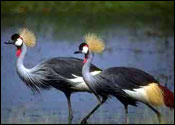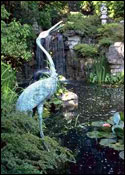|
 The World Heritage listed
Bharatpur Bird Sanctuary as one of the finest bird sanctuaries in India. It houses
more than 415 kinds of birds, out of which 117 birds migrate from places as far
away as Siberia and China. This bird sanctuary also known as Keoladeo Ghana even
houses sambar, chital, nilgai and boar. The park covers an area of 29 sq. km. out
of which 11 sq. km. are marshes and the rest is scrubland and grassland. The World Heritage listed
Bharatpur Bird Sanctuary as one of the finest bird sanctuaries in India. It houses
more than 415 kinds of birds, out of which 117 birds migrate from places as far
away as Siberia and China. This bird sanctuary also known as Keoladeo Ghana even
houses sambar, chital, nilgai and boar. The park covers an area of 29 sq. km. out
of which 11 sq. km. are marshes and the rest is scrubland and grassland.
Most of the parks of the ancient times were developed from
the hunting preserves of the princes. But this park's uniqueness is that it was
the only animal house created by a king (Maharaja) for hunting. 'Keoladeo' is an
ancient Hindu temple devoted to Lord Shiva in the centre of this park and 'Ghana'
means dense, which are in context to the thick forests which covered this area. This is how Bharatpur National Park gets its name Keoladeo Ghana.
 An earthern dam called
the Ajan Dam was constructed in 1760 to protect Bharatpur from the constant floods
during monsoon and the arid lands after monsoon. The Keoladeo lake was born out
of the depression created by extraction of soil for the dam. A very fine system
of small dams, dykes, sluice gates, etc., was made so as to control the water level in different sections. Until hunting and shooting was banned in 1964, this place
of Bharatpur royalty was one of the best duck-shooting wetlands in the world. On
10th March 1982 this area was declared as a National Park and in December 1985 it
was accepted as a World Heritage site. An earthern dam called
the Ajan Dam was constructed in 1760 to protect Bharatpur from the constant floods
during monsoon and the arid lands after monsoon. The Keoladeo lake was born out
of the depression created by extraction of soil for the dam. A very fine system
of small dams, dykes, sluice gates, etc., was made so as to control the water level in different sections. Until hunting and shooting was banned in 1964, this place
of Bharatpur royalty was one of the best duck-shooting wetlands in the world. On
10th March 1982 this area was declared as a National Park and in December 1985 it
was accepted as a World Heritage site.
|
General information
|
|
Area |
22 sq.km. |
|
Altitude |
250 metres |
|
Best Season |
October- February |
|
Languages |
Rajasthani, Hindi, English. |
Siberian Crane
This park welcomes more than 415 species of birds every
year to nestle in its 29 sq. km. area covered with shallow lakes and stunted forest growth and grasslands. These birds migrating from far away countries spend their
winters here before returning to their homes. The birds as small as the Siberian
dusky leaf warbler which is the size of a finger or as large as the Dalmatian pelican,
which is a little less than 2 mts. Many species of cranes, geese, eagles, wheatears,
wagtails, pelicans, warblers, shanks, larks, pipits, flycatchers, buntings, etc.
and other migrating birds are found
here.
 The most popular
amongst all the migrating birds is the Siberian crane or the great white crane.
It migrates every year during winter, covering a distance of almost half the globe.
The journey to this sanctuary is 6400 km. from their breeding grounds in Siberia.
The stay lasts from December to March. The most popular
amongst all the migrating birds is the Siberian crane or the great white crane.
It migrates every year during winter, covering a distance of almost half the globe.
The journey to this sanctuary is 6400 km. from their breeding grounds in Siberia.
The stay lasts from December to March.
|
These fascinating birds are on the verge of extinction and
number only a few hundreds now. The birds from the western parts of the globe migrate to Keoladeo,
coming from the river basin region, in the Aral mountains in Siberia via Afghanistan
and Pakistan. The other stop for them is Feredunkenar in Iran. The Siberian crane
is different from the Indian cranes in its eating habits. Siberian cranes are entirely
vegetarian. They feed on aquatic roots and tubers in loose flocks of five or six.
hundreds now. The birds from the western parts of the globe migrate to Keoladeo,
coming from the river basin region, in the Aral mountains in Siberia via Afghanistan
and Pakistan. The other stop for them is Feredunkenar in Iran. The Siberian crane
is different from the Indian cranes in its eating habits. Siberian cranes are entirely
vegetarian. They feed on aquatic roots and tubers in loose flocks of five or six.
The heronry of Keoladeo is one of the
 finest in the world. This heronry is a breeding ground for seventeen species of
birds namely grey heron, purple heron, night heron, large egret, median egret, little
egret, cattle egret, large cormorant, Indian shag, little cormorant, darter, painted
stork, open-billed stork, black-necked stork, white-necked stork, white ibis and
spoonbill. Each of the birds are specialist feeders like the Siberian crane. Spoonbills
rake the mud with their beaks for mollusks, tadpoles and weed, white egrets and
herons spear their prey, flamingoes sieve water for plankton and geese and brahminy
ducks graze at the water's edge.
finest in the world. This heronry is a breeding ground for seventeen species of
birds namely grey heron, purple heron, night heron, large egret, median egret, little
egret, cattle egret, large cormorant, Indian shag, little cormorant, darter, painted
stork, open-billed stork, black-necked stork, white-necked stork, white ibis and
spoonbill. Each of the birds are specialist feeders like the Siberian crane. Spoonbills
rake the mud with their beaks for mollusks, tadpoles and weed, white egrets and
herons spear their prey, flamingoes sieve water for plankton and geese and brahminy
ducks graze at the water's edge.
This spectacular harmony also houses a range of mammals
and reptiles - Nilgai, sambar, chital, leopard and the wild bear are some of them.
Large rock pythons can also be spotted here, especially at Python point, beyond
the Keoladeo temple, an ideal place for reptile lovers. This fascinating place,
with woodlands and green tall grasses, with marshes and scrublands, is endowed with a unique plethora of
flora and fauna.
tall grasses, with marshes and scrublands, is endowed with a unique plethora of
flora and fauna.
When to visit:
The park is open throughout the year although most visitors
choose to come between October and February, when wintering wildfowl assemble in
thousands on the lakes. The breeding season is between August and October.
How to get there:
The nearest railhead is Bharatpur (2 km) and the nearest
airport is at Agra (50 km).
Accomodation is available at the Forest Lodge (ITDC), Saras
Tourist Bungalow (RTDC), Shanti Kutir, Forest Rest House and private hotels near
the park.
For more information, contact:
Tourist Reception Centre, (RTDC)
Hotel Saras, Agra Road, Tel.: 22542
Guide Services
Approved guides for the National Park can be hired from
the Tourist Reception Centre,
RTDC Hotel Saras, Tel.: 22542 and
Dy. Chief Wildlife Warden, Forest Rest House, Tel.: 22777
Tourist Information Centre
Keoladeo Ghana National Park, Bharatpur, Rajasthan.
|

